Florida’s Big Questions

As Floridians look for solutions to the state’s growing harmful algal bloom problem, a few major questions regarding the causes of these blooms can arise:
- What are the current sources, fate and transport of nutrients from various land uses that stimulate blooms in lakes and estuaries?
- What are the estimates of nutrients coming into and leaving each body of water in Florida?
- What is the amount of nutrients already in lake sediments? What remedial measures are possible?
- What are the economic factors that contribute to increased sources of nutrients, such as the low cost of fertilizers, market prices incentivizing production of crops requiring higher nutrient inputs, and consumer preferences for green lawns?
UF/IFAS research is helping reveal answers to some of these questions. Other questions require much more study. Here is a selection of peer-reviewed, published papers that convey the results of what UF/IFAS researchers have learned thus far about the causes of harmful blooms:
Scales of temporal and spatial variability in the distribution of harmful algae (2011) Edward J. Phlips et al. Harmful Algae 10 (2011) 277–290
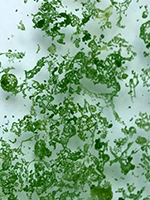
This paper describes the results of a harmful algal bloom study in the Indian River Lagoon from 2006 through 2009 to learn more about how time of year and location affect the distribution, frequency of occurrence, and composition of harmful blooms. It also examined how rainfall, nutrient runoff and other might drive future bloom events. Five potential toxin producing species were observed at bloom levels during the study period.
Climatic influences on autochthonous and allochthonous phytoplankton blooms in a subtropical estuary, St. Lucie Estuary, Florida, USA. Edward J. Phlips et al., Estuaries and Coasts (2012) 35:335–352.

In the St. Lucie Estuary, seasonal changes in air temperatures are modest, but the downpours from the summer storm season deluge the estuary with heavy nutrient inputs. The focus of this study was the response of the phytoplankton community to spatial and temporal shifts in salinity, nutrient concentration, watershed discharges, and water residence times, within the context of temporal patterns in rainfall. From a temporal perspective, both drought and flood conditions negatively impacted phytoplankton biomass potential.
From red tides to green and brown tides: bloom dynamics in a restricted subtropical lagoon under shifting climatic conditions. Ed Phlips et al., Estuaries and Coasts (2015) 38:886–904.
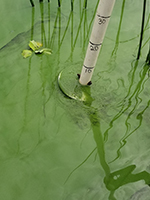 Relationships between shifts in climatic and other environmental conditions and changes in the character and dynamics of phytoplankton blooms were examined in three interconnected subtropical lagoons on the east coast of Florida, i.e., Mosquito Lagoon, Indian River Lagoon, and Banana River Lagoon, from 1997 to 2013.
Relationships between shifts in climatic and other environmental conditions and changes in the character and dynamics of phytoplankton blooms were examined in three interconnected subtropical lagoons on the east coast of Florida, i.e., Mosquito Lagoon, Indian River Lagoon, and Banana River Lagoon, from 1997 to 2013.
Climate change at a crossroad for control of harmful algal blooms. Havens et al. Environmental Science and Technology (2015). DOI: 10.1021/acs.est.5b03990
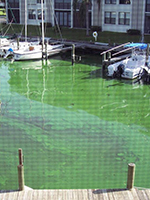
One key decision that communities will confront when mitigating algal blooms is whether spending public or private funds will realistically achieve any reduction. The earth’s changing climate introduces a new and uncontrollable variable. At this juncture, Florida must aggressively tackle excessive nutrient issues before they cause algal bloom problems too large to solve.
It takes two to tango: When and where dual nutrient (N & P) reductions are needed to protect lakes and downstream ecosystems. Hans W. Paerl et al (2016). Environmental Science and Technology (2016). https://doi.org/10.1021/acs.est.6b02575
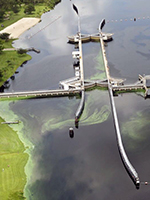
Reducing inputs of excess phosphorus has been the traditional approach to limiting harmful algal blooms formation, but new research suggests that blooms are stimulated more by combined effects of phosphorus and nitrogen. Water managers today need now consider how to balance control of the two elements to most effectively reduce algal blooms, especially in Florida where fresh water flows into saltwater habitats.
Mitigating cyanobacterial harmful algal blooms in aquatic ecosystems impacted by climate change and anthropogenic nutrients. Harmful Algae 54 (2016) 213–222. doi: 10.1016/j.hal.2015.09.009
 Water managers have tried a variety of traditional and experimental approaches to reducing the occurrence of blooms of cyanobacteria. Virtually all those will now be influenced by a changing climate and growing human population. A suite of current and potential management options is objectively examined.
Water managers have tried a variety of traditional and experimental approaches to reducing the occurrence of blooms of cyanobacteria. Virtually all those will now be influenced by a changing climate and growing human population. A suite of current and potential management options is objectively examined.
A novel quantile method reveals spatiotemporal shifts in phytoplankton biomass descriptors between bloom and non-bloom conditions in a subtropical estuary. Natalie G. Nelson et al. (Ed Phlips lab) Marine Ecology Press Series (2017) Vol. 567: 57–78
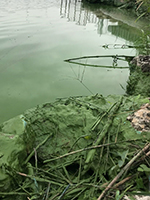 The wax and wane of algal blooms in estuaries reflects the highly dynamic and complex nature of estuarine environments. This study conducted on Florida Bay investigates the question of whether the shift from non-bloom to bloom conditions is matched by a change in the relative importance of local conditions such as the delivery of nutrients from upwellings or land-based runoff, winds and ocean currents. The novel statistical model the researchers developed successfully predicted bloom trends based on select factors and could prove relevant for other bloom-affected estuarine environments.
The wax and wane of algal blooms in estuaries reflects the highly dynamic and complex nature of estuarine environments. This study conducted on Florida Bay investigates the question of whether the shift from non-bloom to bloom conditions is matched by a change in the relative importance of local conditions such as the delivery of nutrients from upwellings or land-based runoff, winds and ocean currents. The novel statistical model the researchers developed successfully predicted bloom trends based on select factors and could prove relevant for other bloom-affected estuarine environments.
Revealing biotic and abiotic controls of harmful algal blooms in a shallow subtropical lake through statistical machine learning. Natalie G. Nelson et al. (Ed Phlips lab) Environmental Science and Technology. (2018) 52, 3527−3535. DOI: 10.1021/acs.est.7b05884
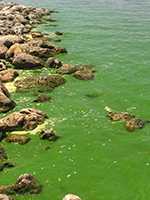
To better understand how harmful blooms of blue-green algae might respond to mitigation efforts, researchers let leading techniques of ‘machine learning’ analyze 17 years’ worth of water quality data from bloom-impacted Lake George in Florida. This first-of-its kind approach and the use of aspects of artificial intelligence provided new insights into how cyanobacteria blooms respond to controls over the long term. In spite of the complexity, researchers found the models could prove especially useful to water managers’ who must figure out nutrient management strategies for bloom mitigation.
Association between trophic state, watershed use, and blooms of cyanobacteria in south-central Chile. Viviana Almanza, Pablo Pedrerosa, H. Dail Laughinghouse IV, Jorge Féleza, Oscar Parraa, Marisol Azócard, Roberto Urrutia. Limnologica (2018). DOI: https://doi.org/10.1016/j.limno.2018.11.004
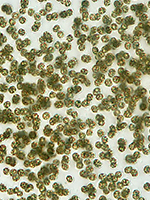
Although blue-green algal blooms are increasing in frequency and distribution worldwide, how they respond to changing environmental conditions for specific lake types is not well understood. UF/IFAS specialist Dail Laughinghouse cooperated on this study investigating variables affecting blooms on lakes in Chile impacted by urban and agricultural use, where little is known about the composition and dynamics of algae communities. The research found that concentrations of phosphorus and nitrogen positively influenced blue-green algal blooms, demonstrating that eutrophication, or too much enrichment by nutrients, is the main factor for bloom formation, and temperature less so.
Additional Reading
- Understanding the 2017-18 Red Tide.
- A Response to Frequently Asked Questions about the 2018 Algae Blooms in Lake Okeechobee, the Caloosahatchee, and St. Lucie Estuaries.
- What is Causing Florida’s Algae Crisis? 5 Questions Answered.
Content developed and curated by Dorothy Zimmerman.
 0
0
